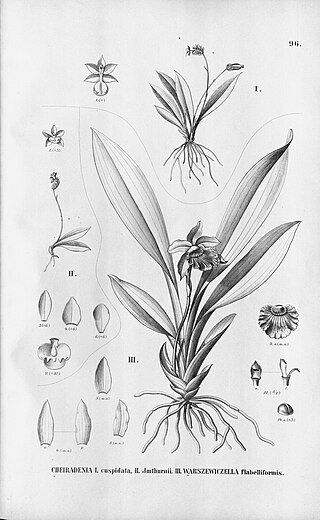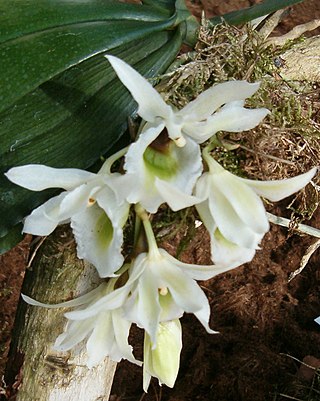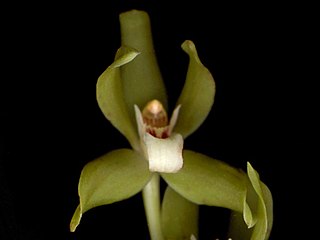
Beclardia is a genus of flowering plants from the orchid family, Orchidaceae. There are two recognized species, both native to islands in the Indian Ocean:

Trichoglottis biglandulosa is a species of flowering plant from the orchid family, Orchidaceae. It is endemic to the island of Java in Indonesia. It is part of the monopodial subtribe Aeridinae and bears nearly white flowers that are proportionally large compared to the rest of the plant.

Chamaeanthus is a genus of flowering plants from the orchid family, Orchidaceae. Two species are currently recognized as of May 2014, both native to Taiwan and southeastern Asia.

Chamaegastrodia is a genus of flowering plants from the orchid family, Orchidaceae. Three species are currently recognized, all native to eastern Asia and the Himalayas.

Cheiradenia is a genus of flowering plants from the orchid family, Orchidaceae. It contains only one known species, Cheiradenia cuspidata, native to northern South America.

Chondrorhyncha is a genus of flowering plants from the orchid family, Orchidaceae. At the present time 7 species are recognized, though many more names have been proposed. All species are native to Colombia, Venezuela and Ecuador.
- Chondrorhyncha hirtziiDodson - Ecuador
- Chondrorhyncha ineditaDressler & Dalström - Colombia
- Chondrorhyncha macronyxKraenzl. - Colombia
- Chondrorhyncha panguensisDodson ex P.A.Harding - Ecuador
- Chondrorhyncha roseaLindl. - Colombia, Venezuela
- Chondrorhyncha suareziiDodson - Ecuador
- Chondrorhyncha velastiguiiDodson - Ecuador

Constantia is a genus of flowering plants from the orchid family, Orchidaceae. It contains 6 known species, all endemic to Brazil:
- Constantia australis(Cogn.) Porto & Brade - Santa Catarina
- Constantia cipoensisPorto & Brade - Minas Gerais
- Constantia cristinaeF.E.L.Miranda - Minas Gerais
- Constantia gutfreundianaChiron & V.P.Castro - Minas Gerais
- Constantia microscopicaF.E.L.Miranda - Minas Gerais
- Constantia rupestrisBarb.Rodr. - Rio de Janeiro
Cryptopylos is a genus of flowering plants from the orchid family, Orchidaceae. It contains only one known species, Cryptopylos clausus, native to Thailand, Laos, Cambodia, Vietnam and Sumatra.

Cuitlauzina is a genus of flowering plants from the orchid family, Orchidaceae. It contains 8 recognized species, native to Mexico, Central America and Colombia.

Eggelingia is a genus of flowering plants from the orchid family, Orchidaceae, and named after the Scots forester, William Julius Eggeling. It contains 3 known species, all native to tropical Africa:
Euryblema is a genus of flowering plants from the orchid family, Orchidaceae. It contains two known species, native to Panama and Colombia.

Eurychone is a genus of flowering plants from the orchid family, Orchidaceae. The genus was founded in 1918 by Rudolf Schlechter. It contains two known species, both native to tropical Africa.

Evotella is a genus of flowering plants from the orchid family, Orchidaceae. It contains only one known species, Evotella rubiginosa, endemic to South Africa.
Gynoglottis is a genus of flowering plants from the orchid family, Orchidaceae. It contains only one known species, Gynoglottis cymbidioides, endemic to Sumatra.

Hagsatera is a genus of flowering plants from the orchid family, Orchidaceae.
Hederorkis is a genus of flowering plants from the orchid family, Orchidaceae. It contains two known species, both native to islands in the Indian Ocean.
Helleriella is a genus of flowering plants from the orchid family, Orchidaceae. It contains two known species, native to Mexico and Central America.
Horvatia is a genus of flowering plants from the orchid family, Orchidaceae. It contains only one known species, Horvatia andicola, which is endemic to Ecuador.

Neogardneria is a genus of flowering plants from the orchid family, Orchidaceae. It contains one known species, Neogardneria murrayana, endemic to Brazil.
Nephrangis is a genus of flowering plants from the orchid family, Orchidaceae. It contains two known species, both native to tropical Africa.


















